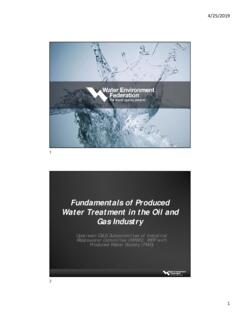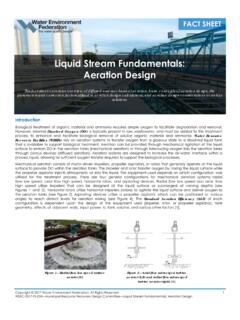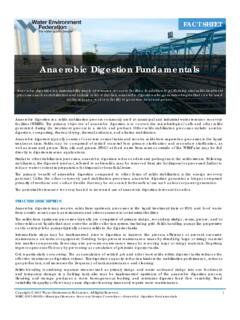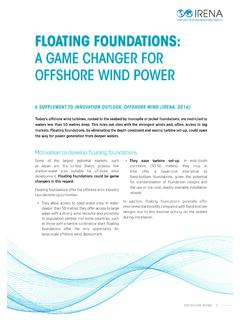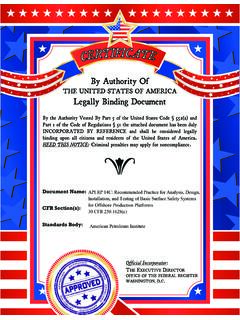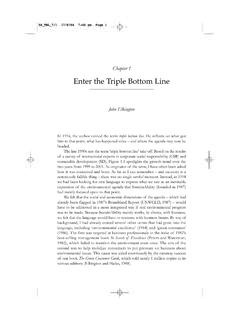Transcription of Produced Water: Oil and Gas Terminology Glossary
1 What Is Produced water ? Produced water is water that comes out of the well with the crude oil during crude oil production. Produced water contains soluble and non-soluble oil/organics, suspended solids, dissolved solids, and various chemicals used in the production process. The ratio of Produced water to oil varies from well to well and over the life of the well. Generally, this ratio is more than 3 and can be more than 20 in some parts of the world. Not only does the flowrate of the Produced water change over time, but so does the composition.
2 The composition of Produced water also varies widely from well to well. Although oil and water are generally thought to not mix well, multiple separation steps are typically required to separate the two. The degree of Produced water treatment depends on the site s treatment requirements-typically deep well injection, reinjection, evaporation ponds, or surface water discharge. As regulations have become more stringent, disposal method costs increase, and water becomes more scarce, beneficial reuse is becoming a more viable option. Depending on the degree of chemical and mechanical emulsification, removal of oil and suspended solids from the water can be a treatment challenge.
3 The American Petroleum Institute (API) gravity, a measure of oil density, varies by region (see Table 6, page 4), which affects the effectiveness of gravity separation methods. Produced water treatment is typically considered an upstream oil and gas (O&G) process. The treatment steps and many terms are unique to this process but common in the industry. This fact sheet has been Produced as a single reference primer that provides a broad overview of definitions, treatments, and use related to Produced water . Typical Produced water Treatment Copyright 2018 water Environment Federation.
4 All Rights Reserved. 1 WSEC-2017-FS-013 IWWC Produced water : Oil and Gas Terminology Glossary Produced water : Oil and Gas Terminology Glossary FACT SHEET Treatment step Removal efficiencies Description Technology Technology description Primary Influent - 500-10,000 ppm total O&G and 200-500 ppm total suspended solids (TSS) Typically removes a rough cut of TSS and free O&G API (which is the organization that established the specifications for the industry in the United States) Typically, a rectangular tank with gravity settling for solids and skimmer for free O&G Effluent - 200-500 ppm free O&G and 100-200 ppm TSS Corrugated plate separators (CPS) or corrugated plate interceptors (CPIs)
5 Contains stacks of angled corrugated plates which result in a reduced settling distance for solids and rise distance for free O&G; prone to plugging in high solids/scaling applications Hydrocyclone Typically used offshore due to space and weight constraints and not affected by boat s pitch and roll; no moving parts but requires pressure drop for separation; sizing based on differences in density; can for either a liquid/liquid (L/L) or solid/liquid (S/L) variety Table 1: Produced water Treatment Equipment General Vapor recovery typically required for environmental and safety reasons, often entailing flaring Minimal pumping of Produced water desired to minimize oil shearing Treatment step Removal efficiencies Description Technology Technology description Secondary Effluent - free O&G - 50-200 ppm* TSS - 50-100 ppm* *dependent on particle size Typically, variety of flotation units introducing small gas bubbles (nitrogen, air, or fuel gas most common) to attach and float O&G with a bottom solids removal device.
6 May use chemical (coagulant and/or flocculant) for better removal efficiencies; industry may use these terms interchangeably Induced gas flotation (IGF) Gas (nitrogen, air, fuel gas, etc.) introduced to a recycle stream via top mixers, which create a supersaturated solution. When the solution is reinjected to the flotator, bubbles are formed, resulting in flotation of solids. Effluent - free O&G - 20-200 ppm* TSS - 50-100 ppm* *dependent on particle size Dissolved gas flotation (DGF) Gas (nitrogen, air, fuel gas, etc.) introduced via pump or saturation tank system. Recycle steam is supersaturated and reinjected into the flotator, where solids float to the surface.
7 Dissolved air flotation (DAF) Same as above but specifically uses air (cannot always be used for Produced water due to safety and environmental concerns). Dissolved nitrogen flotation (DNF) Same as above but specifically uses nitrogen. Compact flotation unit (CFU) Generic term for flotation unit with a short residence time, which is typically desired for offshore water treatment; tangential inlet (centrifugal force) aids in separation. Tertiary Effluent - 1-10 ppm free O&G and 1-10 ppm TSS* *dependent on particle size and media size Various filtration methods Nutshell or walnut shell filters Bed of nut shells (typically 20-30 mesh) that naturally has affinity for free oil; periodically backwashed to remove the oil and dislodge suspended solids through agitation of the filter bed; although not designed for TSS removal, bed inherently also traps TSS.
8 Filter media Consumable media can be filter cartridges, bag filters, or proprietary (organoclay) Multimedia filters (MMF) Bed with layers of media of different density and particle size to trap various-sized TSS; different media densities allow media to restratify during backwash to retain separate layers; not designed for O&G removal, but can be effective at polishing effluent from other treatment processes. Activated carbon filters Granular activated carbon for removal of organics; typically used for offshore flowback with vessels returned onshore when job completed. Microfiltration (MF) or ultrafiltration (UF) Ceramic or polymeric membranes provide a physical barrier to remove particles from the filtrate; few installations but emerging as a technology due to need for better particle removal.
9 Table 1: Produced water Treatment Equipment (continued) Copyright 2018 water Environment Federation. All Rights Reserved. 2 WSEC-2017-FS-013 IWWC Produced water : Oil and Gas Terminology Glossary Onshore vs. offshore Produced water Treatment Typical Units of Measure Onshore offshore Figure 1: Typical Onshore Produced water Treatment (Image provided by A. Larson) Typically not limited by space/weight constraints so primary separation is based on gravity separation Typically preferred to have an equalization tank between three-phase separator (often batch) and primary separator to reduce swings Often requires tertiary treatment but dependent on project requirements Treatment end objectives are dictated by end use, with deep well injection requiring the least rigorous treatment, followed by reuse in the oil field with a moderate treatment requirement, and environmental discharge having the greatest treatment requirement Figure 2: Typical offshore Produced water Treatment (Image provided by A.)
10 Larson) Typical limits do not require tertiary treatment, so usually only primary separation and a compact flotation unit used Limited by space/weight constraints; typically no equalization tank following three phase separator Table 2: Onshore vs. offshore Produced water Treatment Copyright 2018 water Environment Federation. All Rights Reserved. 3 WSEC-2017-FS-013 IWWC Produced water : Oil and Gas Terminology Glossary Figure 3: Typical Produced water Treatment Removal Efficiencies (*may require chemicals) (Image provided by A. Larson) * Abbreviation Definition Reference Context BPD barrels per day 1 barrel = 42 gal Most common flow rates for Produced water pound brine lb/gal 10 lb brine = g/mL Brine density of completion fluid ppg Pound per gallon (lb/gal) 10 ppg = g/mL Brine density of completion fluid CMH Cubic meter per hour m3/hr Flow rates for Produced water CMD Cubic meter per day m3/day Flow rates for Produced water ppm parts per million by weight 1ppm = 1 mg/kg Concentrations of contaminants ppm(v)



